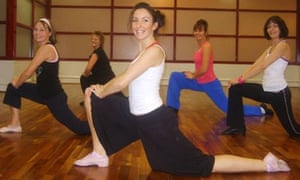Like many girls, and a few boys, I had a stab at ballet classes in my long-forgotten school days. Back then I was as unfazed by dressing up in a pink tutu as dressing up as Cinderella or a pumpkin or a Transformer. Now I am older and wiser, and the chances of me dressing up in anything resembling a sugarplum fairy are very slim, mainly because you have to be, well, very slim – or into fancy dress theme parties.
So what the bejesus am I doing attending a fitness ballet class? Two reasons: ballet is a fantastic way to get fit and lithe – just look at Darcey Bussell – and I’m promised there won’t be a tutu in sight.
Are you sure it isn’t just for wannabe ballerinas?
No previous ballet experience is required. Founder Kirsty Pellant set up the classes in Canterbury with the aim of combining her ballet background with her fitness classes, making ballet accessible to people with none of the technical training. They proved so popular they have now spread all over the country.
Casting a nervous glance around the class on arrival I clock both willowy youngsters and white-haired pensioners, wearing anything from ballet pumps to socks and tracky bottoms. The class kicks straight in with ‘balancés’ and leg raises to high-energy chart tunes which everyone seems to follow pretty easily – some, admittedly, with more grace than others.
Does it deliver?
As the class progresses the routines build steadily, adding basic turns or pirouettes, jumps and ‘arabesque’ kicks. Concentrating on the routines takes my mind off how hard I’m working out. Kirsty is like a high-energy dynamo, giving vocal encouragement and singing along to the sound track (did I mention she’s a professional singer, too?). I can’t help it, I find myself wanting to please her – she’s just so happy!
We then move on to leg-toning exercises, ‘pliés’, jumps and ‘grand battement’ powerful kicks. They don’t let up on my heart rate, which is hammering far harder than on my regular 45-minute run. Mat work means some excruciating stomach crunches, and Jane Fonda-esque leg raises, winding up with deep stretching exercises and a cool-down. I am dismayed to see the pensioner in front of me effortlessly bending her head to her knees – presumably a class regular.
What’s so good about it?

The emphasis of the class is on fitness, rather than ballet. I found my previous ballet experience helpful, but the routines didn’t require it. The idea is to get the benefits of classical ballet moves without the rigid structure. Kirsty explains that the classes can help to improve flexibility, posture, strength and core stability, and to lengthen muscles. So hopefully you’ll end up with long dancers legs, a flat stomach and learn some nifty footwork too. I felt thoroughly worked out by the end of the class.
Perfect if …
You are looking for a sociable fitness class that seriously works you out without taking itself too seriously; if you used to do ballet and want to get back some of your lost fitness without returning to the barre; or are bored with your regular aerobics class and fancy something a bit more challenging and creative.
Is there a downside?
There were plenty of times when I was channelling French and Saunders rather than Ms Bussell. Floating like a feather is not as easy as it looks – at least with step classes or kickboxing there’s no pretence that you’re aspiring to anything other than sweat and burn. If you prefer your fitness regime to be delivered in military commands by a man in combats, best save your dancing for Saturday nights.
• Kirsty Pellant is Group Exercise Manager at DW Sports, Canterbury. Visit fitnessballet.co.uk for more information
Source: Read Full Article
